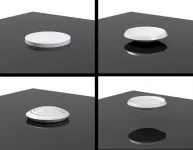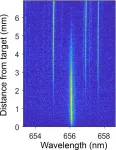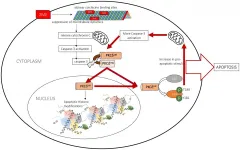(Press-News.org) ITHACA, NY - When it comes to saving endangered species of a certain size, conservationists often have to think outside the box.
This was reinforced by a recent study published in the Journal of Wildlife Diseases, led by faculty in the College of Veterinary Medicine, which analyzed the effects of hanging tranquilized black rhinoceroses upside down by their feet.
"We found that suspending rhinos by their feet is safer than we thought," said Dr. Robin Radcliffe, senior lecturer in wildlife and conservation medicine and first author of the study.
While this finding might sound comical, it is vital information for conservationists working to save these vanishing creatures. To keep rhinos safe from poaching and to distribute individuals across habitats so their gene pools stay healthy, management teams often must move rhinos in remote areas that cannot be accessed by roads or automobiles. This often leaves one option: tranquilizing and airlifting the giant mammals out with a helicopter.
While this technique of moving rhinos from place to place has been used for 10 years, no one had scientifically documented its clinical effects on the animals during transportation, or any potential negative effects once they wake up.
Radcliffe and his colleagues were mindful that the anesthesia drugs used to tranquilize these large mammals can be dangerous.
"These drugs are potent opioids - a thousand times more potent than morphine, with side effects that include respiratory depression, reduced oxygen in the blood and higher metabolism," Radcliffe said. "These side effects can impair rhinoceros health and even lead to mortalities during capture and translocation."
The researchers predicted that hanging rhinos upside down would exacerbate the dangerous effects of these opioids. Horses in this position suffer from impaired breathing, likely due to the heavy abdominal organs pushing against the lungs and chest cavity. Therefore, this method was deemed riskier than transporting the creatures via a platform or sledge with the rhinos laying on their side.
To put the question to rest, Radcliffe and Dr. Robin Gleed, professor of anesthesiology and pain medicine, collaborated with Namibian conservationists to conduct a field study of the highly endangered animals while anesthetized in two different positions: hanging by their feet from a crane to mimic the effects of air transport; or lying on their sides as they would during the immediate period after darting and transport on a sledge.
The researchers traveled to Waterburg National Park in Namibia, where they examined 12 rhinoceroses captured for procedures related to conservation but not being moved. After tranquilizing the animals by darting from a helicopter, the scientists tested each animal while it was hanging upside down and lying on its side, in order to directly compare breathing and circulation in both positions.
The data debunked Radcliffe and his colleague's predictions - that hanging upside down by the feet was worse for rhinos' pulmonary function than lying on their sides. In fact, the rhinos actually fared slightly better when slung up in the sky.
"Hanging rhinos upside down actually improved ventilation (albeit to a small degree) over rhinos lying on their sides," Radcliffe said. "While this was unexpected, and the margins small, any incremental improvement in physiology helps to enhance safety of black rhinoceros during capture and anesthesia."
While this is good news for conservationists working with black rhinos in rugged terrain, Radcliffe said more information is needed.
"Our next step with this research is to extend the time that subject rhinos are suspended upside down to mimic the helicopter-assisted aerial transport of rhinos in the real world," he said, noting that in the remote habitats of Namibia, these helicopter trips can take up to 30 minutes. "Now that we know that it's safe to hang rhinos upside down for short periods of time, we'd like to make sure that longer durations are safe as well."
INFORMATION:
The work was supported by a grant from the Jiji Foundation, the College of Veterinary Medicine and the Namibian Ministry of Environment and Tourism.
The virtual conferencing that has replaced large, in-person gatherings in the age of COVID-19 represents a drastic reduction in carbon emissions, but those online meetings still come with their own environmental costs, new research from the University of Michigan shows.
The research offers a framework for analyzing and tallying the carbon emissions of an online conference based on factors that include everything from energy used by servers and monitors to the resources used to manufacture and distribute the computers involved.
It also includes a case study showing that a May 2020 virtual conference held by the AirMiners carbon removal networking community produced 66 times less greenhouse gas emissions that an in-person gathering in San Francisco would have.
And it highlights ...
How to study the stages children go through as they play together has been highlighted in new research by a Swansea University academic.
Play is a crucial part of a child's development. It is how children develop cognitive skills and learn new information as well as social skills and it is an important topic of research by social scientists.
Dr Pete King, who specialises in play and childhood studies, devised a method of studying the process of children's play - the Play Cycle Observation Method (PCOM) - and has now published research which demonstrates how effective it is as an observational tool.
Working with collaborators Professor LaDonna Atkins and Dr Brandon Burr, his latest ...
Oncotarget recently published "Neuroendocrine carcinoma of uterine cervix findings shown by MRI for staging and survival analysis – Japan multicenter study" which reported that to investigate neuroendocrine carcinoma of the uterine cervix cases for MRI features and staging, as well as pathological correlations and survival.
In 50 patients who underwent a radical hysterectomy and lymphadenectomy without neoadjuvant chemotherapy, intrapelvic T staging by MRI overall accuracy was 88.0% with reference to pathology staging, while patient-based sensitivity, specificity, and accuracy for metastatic ...
Oncotarget recently published "Simvastatin is a potential candidate drug in ovarian clear cell carcinomas" which reported that based on previous studies, the authors assessed the anti-proliferative effect of simvastatin, a Rho GTPase interfering drug, in three OCCC cell lines: JHOC-5, OVMANA and TOV-21G, and one high-grade serous ovarian cancer cell line, Caov3. The authors used the Rho GTPase interfering drug CID-1067700 as a control.
All OCCC cell lines were more sensitive to single-agent simvastatin than the HGSOC cells, while all cell lines were less sensitive to CID-1067700 than to simvastatin.
Most treatments inhibited migration, ...
COLUMBUS, Ohio - A new deep-learning model that can predict how human genes and medicines will interact has identified at least 10 compounds that may hold promise as treatments for COVID-19.
All but two of the drugs are still considered investigational and are being tested for effectiveness against hepatitis C, fungal disease, cancer and heart disease. The list also includes the approved drugs cyclosporine, an immunosuppressant that prevents transplant organ rejection, and anidulafungin, an antifungal agent.
The discovery was made by computer scientists, meaning much more work needs to be done before any of these medications would be confirmed as safe and effective treatments ...
Michelle O'Malley(link is external) has long been inspired by gut microbes. Since she began studying the herbivore digestive tract, the UC Santa Barbara chemical engineering professor has guided several students to their doctoral degrees, won early and mid-career awards (including a recognition from President Obama), attained tenure and advanced to the position of full professor. She even had three children along the way. A constant through it all: goat poop.
"This has been the longest single effort in my lab," said O'Malley, who with her research team way back in 2015 first embarked on an ambitious project to characterize gut microbes in large herbivores. The purpose? To understand how these animals manage, via their microbiomes, ...
Over the past century, a wide variety of models have emerged to explain the complex behaviours which unfold within atomic nuclei at low energies. However, these theories bring up deep philosophical questions regarding their scientific value. Indeed, traditional epistemological tools have been rather elaborated to account for a unified and stabilised theory rather than to apprehend a plurality of models. Ideally, a theory is meant to be reductionist, unifying and fundamentalist. In view of the intrinsic limited precision of their prediction and of the difficulty in assessing a priori their range of applicability, as well as of their specific and disconnected character, traditional ...
RESEARCH TRIANGLE PARK, N.C. -- Army-funded researchers discovered how to make materials capable of self-propulsion, allowing materials to move without motors or hands.
Researchers at the University of Massachusetts Amherst discovered how to make materials that snap and reset themselves, only relying upon energy flow from their environment. This research, published in Nature Materials and funded by the U.S. Army, could enable future military robots to move from their own energy.
"This work is part of a larger multi-disciplinary effort that seeks to understand biological and engineered impulsive systems that will lay the foundations for scalable methods for generating forces for mechanical action and energy storing structures and materials," said Dr. Ralph ...
WASHINGTON -- In a new study, investigators report an optimized approach to using laser-induced breakdown spectroscopy (LIBS) for analyzing hydrogen isotopes. Their new findings could enable improved rapid identification and measurement of hydrogen and other light isotopes that are important in nuclear reactor materials and other applications.
LIBS is promising for measuring hydrogen isotopes because it requires no sample preparation and data can be rapidly acquired with a relatively simple experimental setup. However, quantifying the concentration of hydrogen ...
Oncotarget published "The pro-apoptotic actions of 2-methoxyestradiol against ovarian cancer involve catalytic activation of PKCδ signaling" which reported that the authors have previously shown that a flaxseed-supplemented diet decreases both the incidence and severity of ovarian cancer in laying hens, also induces CYP1A1 expression in liver.
Recently, they have shown that as a biologically derived active component of flax diet, 2MeOE2 induces apoptosis in ovarian cancer cells which is partially dependent on p38 MAPK.
The objective of this Oncotarget study was to elucidate the molecular mechanism of actions of 2MeOE2, a known microtubule disrupting agent, in inducing apoptosis in ovarian tumors.
The objective of this ...





